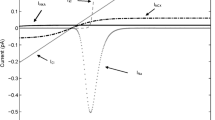Summary
The conductance of the Ca2+-activated K+ channel (g K(Ca)) of the human red cell membrane was studied as a function of membrane potential (V m ) and extracellular K+ concentration ([K+]ex). ATP-depleted cells, with fixed values of cellular K+ (145mm) and pH (≈7.1), and preloaded with ≈27 μm ionized Ca were transferred, with open K+ channels, to buffer-free salt solutions with given K+ concentrations. Outward-current conductances were calculated from initial net effluxes of K+, correspondingV m , monitored by CCCP-mediated electrochemical equilibration of protons between a buffer-free extracellular and the heavily buffered cellular phases, and Nernst equilibrium potentials of K ions (E K) determined at the peak of hyperpolarization. Zero-current conductances were calculated from unidirectional effluxes of42K at (V m −E K)≃0, using a single-file flux ratio exponent of 2.7. Within a [K+]ex range of 5.5 to 60mm and at (V m −E K) ≥ 20 mV a basic conductance, which was independent of [K+]ex, was found. It had a small voltage dependence, varying linearly from 45 to 70 μS/cm2 between 0 and −100 mV. As (V m −E K) decreased from 20 towards zero mVg K(Ca) increased hyperbolically from the basic value towards a zero-current value of 165 μS/cm2. The zero-current conductance was not significantly dependent on [K+]ex (30 to 156mm) corresponding toV m (−50 mV to 0). A further increase ing K(Ca) symmetrically aroundE K is suggested as (V m −E K) becomes positive. Increasing the extracellular K+ concentration from zero and up to ≈3mm resulted in an increase ing K(Ca) from ≈ 50 to ≈ 70 μS/cm2. Since the driving force (V m −E K) was larger than 20 mV within this range of [K+]ex this was probably a specific K+ activation ofg K(Ca). In conclusion: The Ca2+-activated K+ channel of the human red cell membrane is an inward rectifier showing the characteristic voltage dependence of this type of channel.
Similar content being viewed by others
References
Bennekou, P. 1984. K+-valinomycin and chloride conductance of the human red cell membrane. Influence of the membrane protonophore carbonylcyanidem-chlorophenylhydrazone.Biochim. Biophys. Acta 776:1–9
Grygorczyk, R., Schwarz, W. 1983. Properties of the Ca2+-activated K+ conductance of human red cells as revealed by the patch-clamp technique.Cell Calcium 4:499–510
Grygorczyk, R., Schwarz, W., Passow, H. 1984. Ca2+-activated K+ channels in human red cells.Biophys. J. 45:693–698
Hagiwara, S., Miyazaki, S., Rosenthal, N.P. 1976. Potassium current and the effect of cesium on this current during anomalous rectification of the egg cell membrane of a starfish.J. Gen. Physiol. 67:621–638
Hagiwara, S., Takahashi, K. 1974. The anomalous rectification and cation selectivity of the membrane of a starfish egg cell.J. Membrane Biol. 18:61–80
Hamill, O.P. 1981. Potassium channel currents in human red blood cells.J. Physiol. (London) 319:97P-98P
Heinz, A., Passow, H. 1980. Role of external potassium in the calcium-induced potassium efflux from human red blood cell ghosts.J. Membrane Biol. 57:119–131
Hille, B. 1984. Ionic channels of excitable membranes. pp. 109–112. Sinauer Associates, Sunderland, Massachusetts
Hodgkin, A.L., Horowicz, P. 1959. The influence of potassium and chloride ions on the membrane potential of single muscle fibres.J. Physiol. (London) 148:127–160
Hodgkin, A.L., Huxley, A.F. 1952. The components of membrane conductance in the giant axon ofLoligo.J. Physiol. (London) 116:449–472
Hodgkin, A.L., Keynes, R.D. 1955. The potassium permeability of a giant nerve fibre.J. Physiol. (London) 128:61–88
Hoffman, J.F., Yingst, D.R., Goldinger, J.M., Blum, R.M., Knauf, P.A. 1980. On the mechanism of Ca-dependent K transport in human red blood cells.In: Membrane Transport in Erythrocytes: Alfred Benzon Symposium, No. 14. U.V. Lassen, H.H. Ussing, and J.O. Wieth, editors. pp. 178–195. Munksgaard, Copenhagen
Hoffmann, E.K., Sjøholm, C., Simonsen, L.O. 1983. Na+, Cl− cotransport in Erhlich ascites tumor cells activated during volume regulation (regulatory volume increase).J. Membrane Biol. 76:269–280
Horowicz, P., Gage, P.W., Eisenberg, R.S. 1968. The role of the electrochemical gradient in determining potassium fluxes in frog striated muscle.J. Gen. Physiol. 51:193s-203s
Knauf, P.A., Fuhrmann, G.F., Rothstein, S., Rothstein, A. 1977. The relationship between anion exchange and net anion flow across the human red blood cell membrane.J. Gen. Physiol. 69:363–386
Knauf, P.A., Riordan, J.R., Schuhmann, B., Wood-Guth, I., Passow, H. 1975. Calcium-potassium-stimulated net potassium efflux from human erythrocyte ghosts.J. Membrane Biol. 25:1–22
Kramhøft, B., Lambert, I.H., Hoffmann, E.K., Jørgensen, F. 1986. Activation of KCl cotransport in Ehrlich ascites tumor cells.Am. J. Physiol. 251:C369-C379
Latorre, R., Miller, C. 1983. Conduction and selectivity in potassium channels.J. Membrane Biol. 71:11–30
Macey, R.I., Adorante, J.S., Orme, F.W. 1978. Erythrocyte membrane potentials determined by hydrogen ion distribution.Biochim. Biophys. Acta 512:284–295
Schwarz, W., Passow, H. 1983. Ca2+-activated K+-channels in erythrocytes and excitable cells.Annu. Rev. Physiol. 45:339–347
Spalding, B.C., Senyk, O., Swift, J.G., Horowicz, P. 1981. Unidirectional flux ratio for potassium ions in depolarized frog skeletal muscle.Am. J. Physiol. 241:c68-c75
Stampe, P., Vestergaard-Bogind, B. 1985. The Ca2+-sensitive K+-conductance of the human red cell membrane is strongly dependent on cellular pH.Biochim. Biophys. Acta 815:313–321
Ussing, H.H. 1949. The distinction by means of tracers between active transport and diffusion.Acta Physiol. Scand. 19:43–56
Vestergaard-Bogind, B. 1983. Spontaneous inactivation of the Ca2+-sensitive K+-channels of human red cells at high intracellular Ca2+ activity.Biochim. Biophys. Acta 730:285–294
Vestergaard-Bogind, B., Stampe, P. 1984. Trans to cis proton concentration gradients accelerate ionophore A23187-mediated net fluxes of Ca2+ across the human red cell membrane.Biochim. Biophys. Acta 775:328–340
Vestergaard-Bogind, B., Stampe, P., Christophersen, P. 1985a. Single-file diffusion through the Ca2+-activated K+ channel of human red cells.J. Membrane Biol. 88:67–75
Vestergaard-Bogind, B., Stampe, P., Christophersen, P. 1985b. Some characteristics of the Ca2+-activated K+ channel of the human red cell membrane.Acta Physiol. Scand. 124:149
Yingst, D.R., Hoffman, J.F. 1984. Ca-induced K transport in human red blood cell ghosts containing arsenazo III.J. Gen Physiol. 83:19–45
Author information
Authors and Affiliations
Rights and permissions
About this article
Cite this article
Vestergaard-Bogind, B., Stampe, P. & Christophersen, P. Voltage dependence of the Ca2+-activated K+ conductance of human red cell membranes is strongly dependent on the extracellular K+ concentration. J. Membrain Biol. 95, 121–130 (1987). https://doi.org/10.1007/BF01869157
Received:
Revised:
Issue Date:
DOI: https://doi.org/10.1007/BF01869157




